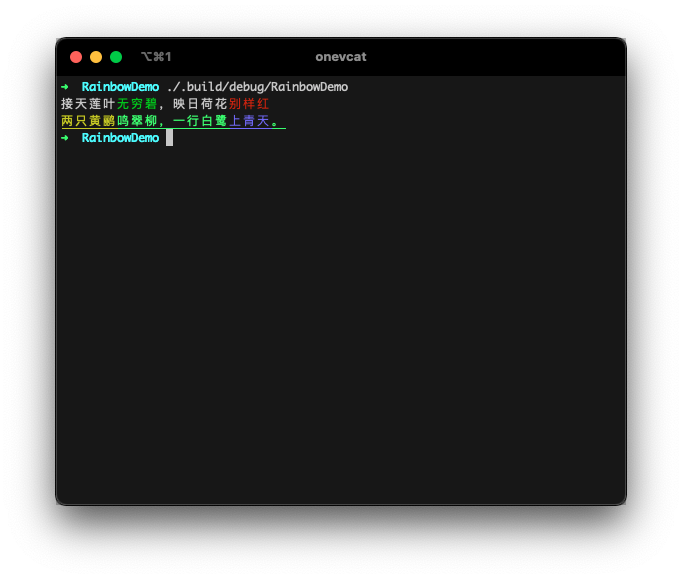Rainbow adds text color, background color and style for console and command
line output in Swift. It is born for cross-platform software logging
in terminals, working in both Apple's platforms and Linux.
Nifty way, using the String extension, and print the colorized string.
import Rainbow
print("Red text".red)
print("Blue background".onBlue)
print("Light green text on white background".lightGreen.onWhite)
print("Underline".underline)
print("Cyan with bold and blinking".cyan.bold.blink)
print("Plain text".red.onYellow.bold.clearColor.clearBackgroundColor.clearStyles)It gives you something like this:
If you are developing a cross platform software in Swift,
Swift Package Manager might
be your choice for package management. Just add the url of this repo to your
Package.swift file as a dependency:
import PackageDescription
let package = Package(
name: "YourAwesomeSoftware",
dependencies: [
.package(url: "https://github.com/onevcat/Rainbow", .upToNextMajor(from: "4.0.0"))
],
targets: [
.target(
name: "MyApp",
dependencies: ["Rainbow"]
)
]
)Then run swift build whenever you get prepared.
You could know more information on how to use Swift Package Manager in Apple's official page.
Swift string interpolation is supported. Define the color for part of the string. Or even create nested colorful strings. The inner color style will be kept:
print("接天莲叶\("无穷碧".green),映日荷花\("别样红".red)")
print("\("两只黄鹂".yellow)鸣翠柳,一行白鹭\("上青天".lightBlue)。".lightGreen.underline)8-bit color is fully supported, for both text color and background color:
print("停车坐爱\("枫林晚".bit8(31)),\("霜叶".bit8(160))红于\("二月花".bit8(198))。")
print("\("一道残阳".bit8(202))铺水中,\("半江瑟瑟".bit8(30).onBit8(226))半江红。")It also accepts a Hex color. Rainbow tries to convert it to a most approximate .bit8 color:
print("黑云压城\("城欲摧".hex("#666")),甲光向日\("金鳞开".hex("000000").onHex("#E6B422"))。")
print("日出江花\("红胜火".hex(0xd11a2d)),春来江水\("绿如蓝".hex(0x10aec2))")Valid format:
"FFF","#FFF","FFFFFF","#FFFFFF",0xFFFFFF
A few terminal emulators supports 24-bit true color. If you are sure the 24-bit colors can be displayed in your user's terminal, Rainbow has no reason to refuse them!
print("疏影横斜\("水清浅".bit24(36,116,181)),暗香浮动\("月黄昏".bit24(254,215,26))")
print("\("春色满园".hex("#ea517f", to: .bit24))关不住,\("一枝红杏".hex("#f43e06", to: .bit24))出墙来。")By default, Rainbow should be smart enough to detect the output target, to determine if it is a tty. For example, it automatically output plain text if written to a file:
// main.swift
print("Hello Rainbow".red)
$ .build/debug/RainbowDemo > output.txt
// output.txt
Hello RainbowThis is useful for sharing the same code for logging to console and to a log file.
You can manually change this behavior by either:
- Set the
Rainbow.outputTargetyourself. - Pass a
"NO_COLOR"environment value when executing your app. - Or set the
Rainbow.enabledtofalse.
You can also use the more verbose way if you want:
import Rainbow
let output = "The quick brown fox jumps over the lazy dog"
.applyingCodes(Color.red, BackgroundColor.yellow, Style.bold)
print(output) // Red text on yellow, bold of course :)Or even construct everything from scratch:
let entry = Rainbow.Entry(
segments: [
.init(text: "Hello ", color: .named(.magenta)),
.init(text: "Rainbow", color: .bit8(214), backgroundColor: .named(.lightBlue), styles: [.underline]),
]
)
print(Rainbow.generateString(for: entry))Please remember, the string extensions (such as "Hello".red) is O(n). So if you are handling a huge string or very
complex nesting, there might be a performance issue or hard to make things in stream. The manual way is a rescue for these
cases.
Thanks to the open source of Swift, developers now could write cross platform programs with the same language. And I believe the command line software would be the next great platform for Swift. Colorful and well-organized output always helps us to understand what happens. It is really a necessary utility to create wonderful software.
Rainbow should work well in both OS X and Linux terminals. It is smart enough
to check whether the output is connected to a valid text terminal or not, to
decide the log should be modified or not. This could be useful when you want to
send your log to a file instead to console.
Follow and contact me on Twitter or Sina Weibo. If you find an issue, just open a ticket on it. Pull requests are warmly welcome as well.
Open-source projects cannot live long without your help. If you find Kingfisher is useful, please consider supporting this project by becoming a sponsor. Your user icon or company logo shows up on my blog with a link to your home page.
Become a sponsor through GitHub Sponsors. ❤️
Rainbow is released under the MIT license. See LICENSE for details.
















